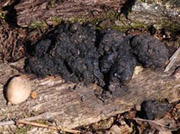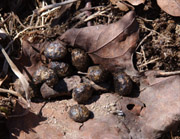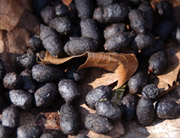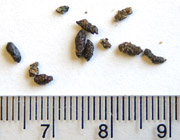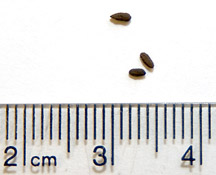Scat and Pellets
All animals leave droppings because they all have to eat and then get rid of their waste. Scientists call these dropping "scat." Insects, snakes, lizards, frogs, and mammals all leave scat behind. In addition to scat, animals often leave little bits of themselves behind. You can read about that on another web page. On the current page, you can read about the following kinds of scat so you know what to look for:
- mammals
- birds
- invertebrates (including earthworms)
Scat is one of the most important signs to look for when tracking animals. All animals leave scat in one form or another, even us (though we don't tend to leave it on the ground!). An animal's scat can tell us what they eat, where they spend most of their time, if they're sick, and what kind of animal it is that we're tracking. Different kinds of animals leave different kinds of scat, and knowing how to tell which is which can help us figure out what kinds of animals live nearby.
If you find scat, never pick it up! Animals carry diseases that might be passed through their feces.
Mammals
The shape and size of mammal scat will tell you the most about who left it. This table will help you to decide what kinds of mammals might have left some scat that you find.
The scat of many wild carnivores, such as coyotes and foxes, will be thick with the fur of the animals they've eaten. The photo above shows aged coyote scat. The photos below show raccoon scat.
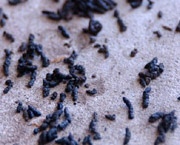
Bat guano is usually small, dry, oval pellets. Guano collects under roost sites (where they sleep during the day), so you often see bat guano in small piles.
Long and Thin Scat: Bats
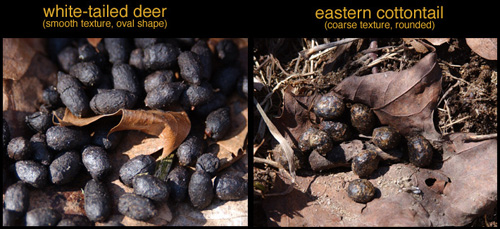
Deer and rabbit droppings are often confused. This picture shows how to tell them apart.
Birds
Bird droppings are a good way to find out if a bird has been around. If you find a lot of it under a tree or building ledge, it might mean that the birds have nests in the tree, like to roost there, or that the tree provides something they like to eat. There are as many different kinds of bird droppings as there are birds, but it is hard to tell what kind of bird left it. Sometimes, though, we can tell what kind of food they have been eating by looking at their droppings.
Bird droppings usually look like colored paint blotches because they have fallen from a long way to get to the ground. Sometimes bird droppings are more three-dimensional if they are left on branches or by a bird that was on the ground at the time.
Most bird droppings are pasty and white, but some are different. The photo to the right shows grouse droppings, which are not pasty or white.
There are also things called pellets, which are the undigested bones and hair that owls, eagles, and hawks spit up. Pellets are mostly round and are not scat, but should still be handled with the same caution.
Invertebrates
Invertebrates leave droppings, too, usually very small ones. Here is a picture of cockroach droppings with a metric ruler to show the scale.
Earthworm castings are an interesting kind of scat. Earthworms dig tunnels in the ground by eating dirt. They often leave small, neat piles of smooth dirt on the ground. Though this dirt has been through their bodies, it is virtually the same as any other dirt.
All animals leave droppings because they all have to eat and then get rid of their waste. Insects, snakes, lizards, frogs, and mammals all leave scat behind. If you see something that looks like scat and you don't have any idea what may have left it, you have still found evidence that something has been there before you.


